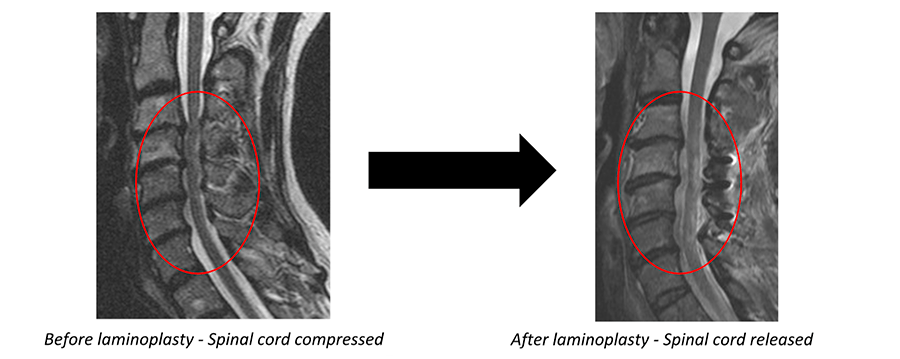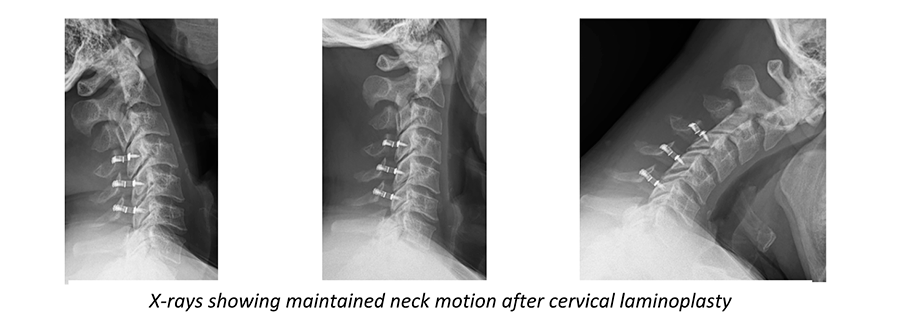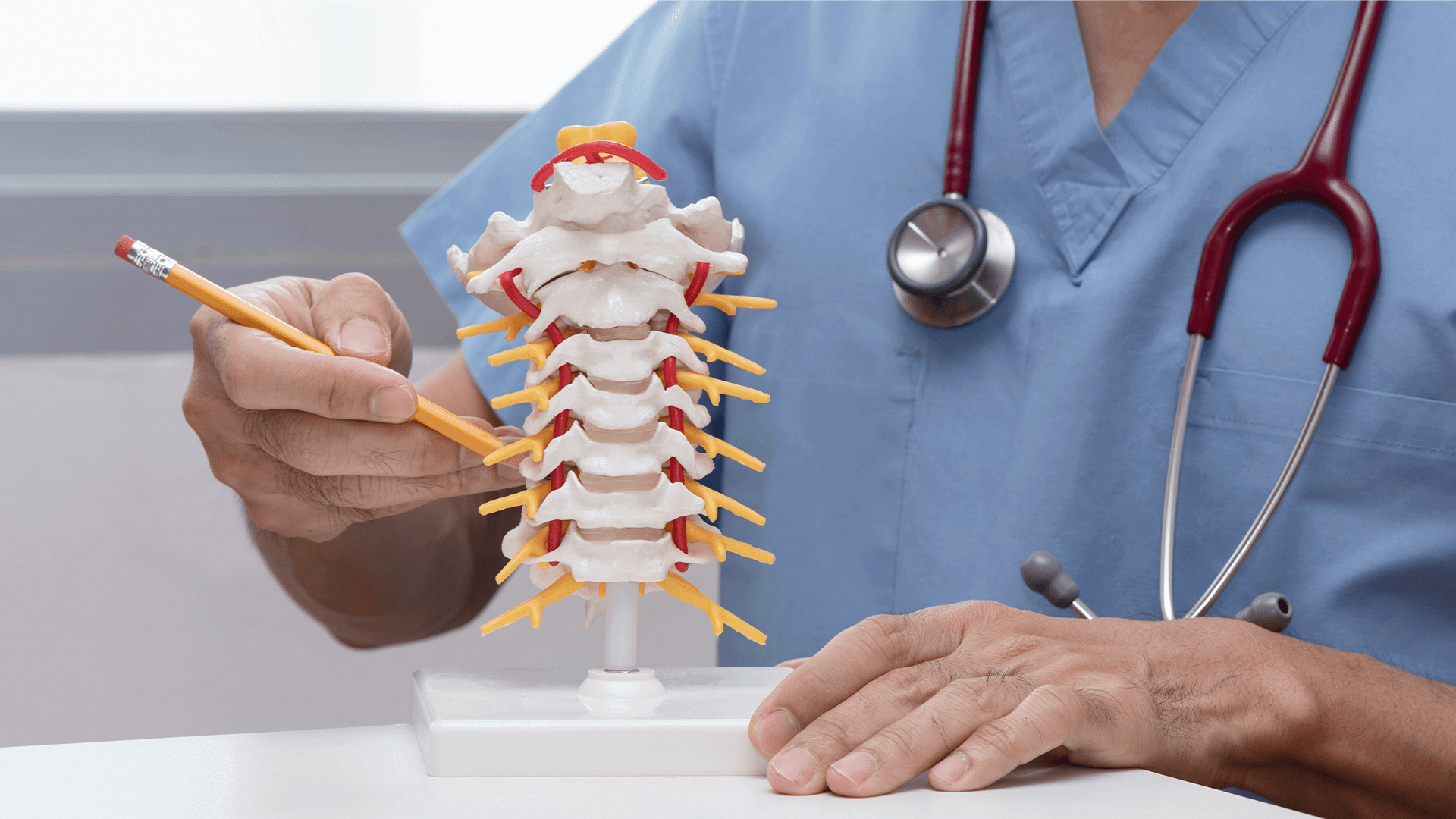Cervical Laminoplasty – Everything You Need to Know
A Cervical Laminoplasty is a surgical procedure that widens the channel through the spine, known as the spinal canal.
This surgical treatment is intended to relieve compression on the spinal cord and spinal nerves. The primary indication for a Cervical Laminoplasty is to prevent neurological injury.
What is Cervical Laminoplasty?
The cervical spine is made up of seven vertebrae (bones).
An important part of the vertebrae are the lamina, a thin layer of bone which forms the “roof” or the back portion of the spinal canal. The spinal cord and spinal nerves travel from the brain through the spinal canal to reach the rest of the body.
A Cervical Laminoplasty refers to a surgical procedure that relieves compression on the spinal cord and spinal nerves due to spinal stenosis or narrowing of the spinal canal 1. By creating more space and relieving pressure on the spinal cord, a cervical laminoplasty reduces the chance of further injury and creates an environment that may allow recovery of pre-existing neurological deficits 2.
When is a Cervical Laminoplasty performed?
Compression due to stenosis is often due to the formation of bone spurs, bony projections off of the vertebrae, which are a natural result of the aging process.
These bone spurs project into the spinal canal, take up space, and place pressure on the spinal cord and spinal nerves. The compression of the nerves leads to symptoms of a myelopathy, spinal cord dysfunction, or radiculopathy, spinal nerve irritation. These symptoms can range from pain and weakness in the arms or legs, numbness, poor hand coordination, difficulty with walking and balance, and bowel/bladder control issues. These symptoms can range in severity, and it is important to identify these symptoms early, particular those that compromise function 3.
The conditions that may be with a Cervical Laminoplasty include:
- Cervical spondylotic myelopathy
- Ossification of posterior longitudinal ligament
- Cervical stenosis/degenerative disc disease
- Spinal cord tumors or vascular malformations
Alternative surgical treatments for these same conditions include:
- Anterior cervical discectomy or corpectomy (ACDF/ACCF)
- Posterior cervical laminectomy with or without a fusion
- Combined anterior and posterior reconstructions of the cervical spine (meant to address more complex spinal deformities)
There are many factors involved in the surgical decision-making process when a patient presents with symptoms from spinal stenosis, including age and general health, severity and extent of the spinal cord/nerve compression, curvature of the cervical spine, and presence or absence of associated neck pain. It is important to talk to your surgeon about these details 4.

How is a Cervical Laminoplasty performed?
A Cervical Laminoplasty is performed under general anesthesia. The incision is made along the back of the neck and the muscles are separated to reach the spine.
In contrast to a Laminectomy, where the bones and ligaments are removed to create space, a Laminoplasty creates a hinge on the side of the lamina, allowing the lamina to open like a door and widening the spinal canal. This type of laminoplasty procedure is referred to as the “open door laminoplasty”. By repositioning the lamina bones, instead of removing the lamina, the majority of normal bone and ligament are maintained providing stability. Small metallic plates are inserted to ensure that the “door” is supported open.
In addition, the surgeon may perform a Foraminotomy, which is a procedure that enlarges the neural foramen, which is the channel where individual spinal nerves exit. This allows any pressure on the nerve roots to be relieved as well.
The advantage of the laminoplasty is that adequate space is provided without too much compromise of the spine’s supporting elements. The spine’s stability and mobility are maintained. The Cervical Laminoplasty procedure avoids the negative consequences of a spinal fusion.

What can I expect after a Cervical Laminoplasty?
After a Cervical Laminoplasty, many patients are able to be discharged from the hospital within a day or two. Depending on the severity of symptoms due to the stenosis and compression, a period of physical therapy and rehabilitation may be recommended.
Post operatively, patients neck movements are not restricted and an external or supportive collar is not required. Discomfort is normal, and improves over the course of a few weeks. A short interval of pain medication may be necessary. Patients can return to their full level of activity and normal life several weeks after surgery. As opposed to a fusion, there are no anticipated long-term limitations after this surgical treatment.
- Weinberg, D.S. and J.M. Rhee, Cervical laminoplasty: indication, technique,
complications. J Spine Surg, 2020. 6(1): p. 290-301. - Matz, P.G., et al., Cervical laminoplasty for the treatment of cervical degenerative
myelopathy. J Neurosurg Spine, 2009. 11(2): p. 157-69. - Kaiser, M.G., Multilevel cervical spondylosis. Neurosurg Clin N Am, 2006. 17(3): p. 263-
75, vi. - Mummaneni, P.V., et al., Cervical surgical techniques for the treatment of cervical
spondylotic myelopathy. J Neurosurg Spine, 2009. 11(2): p. 130-41.

About Dr. Michael G. Kaiser
Dr. Michael G. Kaiser is a nationally recognized neurosurgeon in North Jersey and is a proud member of Neurosurgeons of New Jersey, practicing out of their Ridgewood office conveniently located on East Ridgewood Avenue. Dr. Kaiser specializes in complex and minimally invasive spine surgeries.
Please call today to schedule a consultation with me.
(551) 284-3265
Request a consultation with Dr. Kaiser

